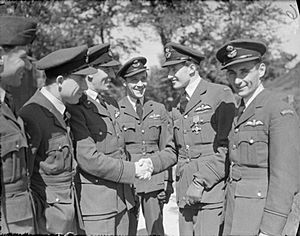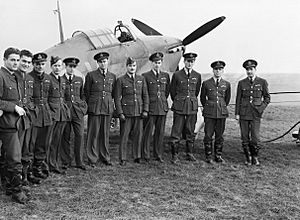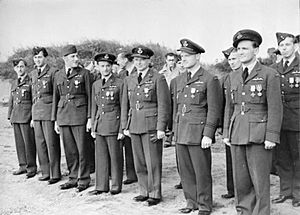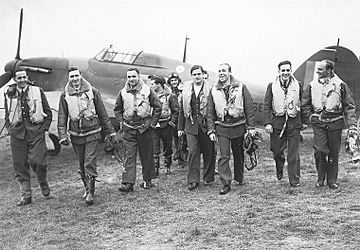Non-British personnel in the RAF during the Battle of Britain facts for kids
The Royal Air Force (RAF) and Fleet Air Arm had many brave people from outside the United Kingdom serving even before World War II began. Many of these volunteers fought in the famous Battle of Britain in the summer of 1940. A lot of these heroes were citizens from different parts of the British Empire. There were also many refugees and people who had to leave their homes in German-occupied Europe, as well as some Americans.
The RAF lists 574 pilots from countries other than the UK who flew at least one mission during the Battle of Britain (July 10 to October 31, 1940). This was alongside 2,353 British pilots. All these pilots, no matter where they came from, are known as "The Few"—a special name given to them by Winston Churchill.
Contents
Why People Joined the RAF
Before the war started, the RAF knew that trouble was coming in Europe. So, they started plans to make their air force much bigger. This included inviting pilots from other British Commonwealth countries like Australia, Canada, New Zealand, South Africa, and Southern Rhodesia to join for short periods.
In December 1939, the governments of Australia, Canada, New Zealand, and the UK signed an agreement to create the British Commonwealth Air Training Plan (BCATP). This plan had a few big effects:
- First, they set up joint training centers for aircrew (pilots, navigators, etc.) in each member country, including Southern Rhodesia.
- Second, all these air forces shared their trained aircrew and ground staff. They were sent to units where they were needed most, no matter their nationality.
- Third, under a special part of the agreement (Article XV), the Royal Australian Air Force (RAAF), Royal Canadian Air Force (RCAF), and Royal New Zealand Air Force (RNZAF) formed their own squadrons to fight under RAF control. These "Article XV squadrons" had numbers in the 400s so they wouldn't get mixed up with regular RAF units.
Most of these new squadrons and personnel were still training or weren't involved in fighter battles during the Battle of Britain. However, No. 1 Squadron RCAF did join the fighting from August 1940.
Countries That Helped
Australia
When the war started, about 450 Australian pilots were already serving in the RAF. Australia was one of the first countries to declare war on Germany. The Royal Australian Air Force (RAAF) was quite old, formed in 1921.
Under the Empire Air Training Scheme (EATS), over 37,000 aircrew were trained in Australia between 1939 and 1945. However, it took some time for RAAF personnel to join the fight in Europe. This was because:
- The huge training program meant the first new RAAF aircrews didn't finish training until November 1940.
- The RAAF focused more on supporting ground troops and patrolling the seas.
- Australia wanted its airmen to serve with Australian units whenever possible. Australian fighter squadrons (Article XV) didn't become active in Europe until mid-1941.
Still, more than 30 Australians fought in RAF Fighter Command during the Battle of Britain. The top Australian pilot in the battle was Flight Lieutenant Pat Hughes of No. 234 Squadron RAF. He shot down 14 enemy planes before he died on September 7, 1940.
No. 10 Squadron RAAF, a flying boat squadron, was also based in Britain and helped patrol the coasts.
Barbados
In 1940, the small Caribbean island of Barbados was a British crown colony (a territory ruled directly by the British Crown). Aubrey "Sinbad" de Lisle Inniss (1916–2003) was the only Barbadian pilot in the Battle of Britain. He was born in Barbados and joined the RAF in 1939. During the battle, he flew a Bristol Blenheim IF night fighter with No. 236 Squadron RAF and shot down a German Heinkel He 111 in September 1940. Inniss survived the war and became a top pilot, retiring from the RAF in 1957.
Belgium
When Belgium was invaded in May 1940, it had a small air force. Many Belgian pilots managed to escape to Britain after their country surrendered. A good number of Belgians were also training in France. Despite some hesitation from their government, 124 Belgians reached Britain by August 1940. However, only a few were ready to fight in the Battle of Britain.
The RAF officially recognizes 30 Belgians who took part in the Battle of Britain. At the time, Belgian pilots were mixed into British units and didn't have their own squadrons. By the summer of 1940, about half of No. 609 Squadron RAF, which flew Spitfire fighters, were Belgians. Nos. 235 and 236 Squadrons also had many Belgian pilots. Belgium provided the largest group of pilots from outside Eastern Europe or the Commonwealth.
Belgian pilots shot down 21 German aircraft during the battle. Between seven and 10 Belgians were killed. Later in the war, two all-Belgian squadrons were formed. In total, 1,200 Belgians served in the RAF during the war.
Canada
Many Canadians served in the fighter squadrons that fought off the German Luftwaffe in the summer of 1940. The RAF officially lists 83 Canadian pilots in fighter operations, but the RCAF believes the number was over 100. Of these, 23 died during the battle, and 30 more were killed later in the war. This difference in numbers is because some Canadians were in RCAF units, some RCAF members were in RAF units, and some Canadians were directly in the RAF. About 200 other Canadian pilots flew with bomber and coastal units, and around 2,000 Canadians worked as ground crew.
Of these, 26 were in No. 1 Squadron RCAF, flying Hurricanes. This squadron arrived in Britain after the Battle of Dunkirk. It was later renamed No. 401 "City of Westmount" Squadron RCAF under the British Commonwealth Air Training Plan. It was the only fighter unit from the Commonwealth air forces to fight in the Battle of Britain.
No. 1 Squadron had a tough start. On August 24, 1940, two of its Hurricanes mistakenly shot down a British Bristol Blenheim bomber, thinking it was a German Junkers Ju 88. This is known as friendly fire. No. 1 Squadron became the first RCAF unit to fight enemy planes on August 26, 1940, claiming three kills. By mid-October, the squadron had claimed 31 enemy planes destroyed.
Other Canadians were spread across different RAF squadrons. On July 11, Canada had its first fighter pilot casualty. Pilot Officer D. A. Hewitt from New Brunswick, flying a Hurricane with No. 501 Squadron RAF, attacked a German Dornier Do 17 bomber and was hit. His plane crashed into the sea. Another Canadian pilot, Richard Howley, died eight days later.
One Canadian airman even flew with No. 303 (Polish) Squadron. A total of 12 Canadian pilots, including Willie McKnight, flew with No. 242 Squadron RAF at different times during the battle. On August 30, under the command of Squadron Leader Douglas Bader, nine 242 Squadron planes attacked 100 enemy aircraft over Essex. They claimed 12 victories without any losses.
Canadians also helped stop the Luftwaffe's last big daylight attack. On September 27, 303 Squadron and 1 Squadron RCAF attacked the first wave of German bombers. They claimed seven planes destroyed.
The top Canadian pilot during the Battle was Flt Lt Hamilton Upton of No. 43 Squadron RAF, who claimed 10.25 planes shot down.
Czechoslovakia
Many Czechoslovak pilots had escaped to France after Hitler took over their country in March 1939. They fought in the short Battle of France, gaining important combat experience. When France quickly fell, Czechoslovak soldiers and airmen left for Britain. There, they formed their own squadrons. Nearly 90 Czechoslovak pilots flew in the Battle of Britain, with No. 310 and No. 312 (Czechoslovak) Squadrons, RAF, becoming active during the battle. Some Czechs also served in other RAF Fighter Command squadrons. Both Czechoslovak squadrons flew Hurricanes.
Czechoslovak fighters became known for their aggressive fighting style, skill, and bravery. In total, 86 Czechoslovaks (84 Czechs and 2 Slovaks) served, claiming almost 60 enemy planes shot down. Nine pilots were killed. The top Czechoslovak pilot was Sgt. Josef František, who flew with No. 303 (Polish) Squadron. He claimed 17 confirmed kills, making him the highest-scoring non-British pilot in the Battle of Britain.
France
French volunteers and Free French forces served in 245 and 615 Squadrons. 13 French pilots are recognized in the Battle of Britain Roll of Honour.
Ireland
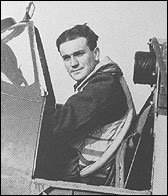
The Irish Free State (officially called Ireland from 1937) became independent from British rule in 1922. Relations between the two countries were still difficult in 1940. Even though Ireland was technically a British dominion, it stayed neutral during World War II.
However, many individual Irish citizens joined the British military. Ten pilots from Ireland fought in the RAF during the Battle of Britain. One of them, Brendan "Paddy" Finucane, became a famous pilot who would claim a total of 32 enemy aircraft before he was killed in 1942. Finucane grew up in County Dublin. He and his family moved to England in 1936, and he joined the Royal Air Force at 17. Finucane started flying missions in July 1940 and shot down his first German plane on August 12. He became the youngest Wing Commander in the RAF at 21.
The world's last confirmed surviving Battle of Britain pilot as of March 2023 is Group Captain John Hemingway. He was born in Dublin and returned to live in Ireland in 2011. During the Battle, he damaged a Bf 109 and was shot down twice himself.
Jamaica
In 1940, the island of Jamaica was a crown colony under British rule. The only Jamaican recognized in the Battle of Britain was Herbert Capstick, a Pilot Officer of British origin, born in Jamaica in 1920. Capstick served in No. 236 Squadron RAF and helped with anti-submarine operations in the English Channel. He survived the war and returned to live in Jamaica.
Newfoundland
Newfoundland was a separate dominion within the British Empire at the time. Pilot Officer Richard Alexander Howley is recognized as the only Newfoundlander to serve in the RAF during this period. Howley served in No. 141 Squadron RAF, flying Boulton Paul Defiant turret fighters. He was shot down over Dover on July 19, 1940, and was never found.
New Zealand

New Zealand was among the first countries to declare war on Germany. The Royal New Zealand Air Force (RNZAF) was formed in 1937 but had less than 1,200 people by September 1939. The Empire Air Training Scheme sent about 100 RNZAF pilots to Europe by the time the battle began. Unlike other dominions, New Zealand did not insist that its aircrews serve only with RNZAF squadrons. This helped them join the fight faster. By January 1941, 1,500 fully trained pilots were being produced each year.
The most important New Zealander in the battle was Air Vice Marshal Keith Park. He was a top pilot in the First World War and had been in the RAF since it started. During the Battle of Britain, he was in charge of No. 11 Group, which defended London and south-east England.
The RAF recognizes 135 fighter aircrew from New Zealand who served in the battle. Several New Zealanders became top pilots, including Pilot Officer Colin Falkland Gray (No. 54 Squadron) with 14 claims, Flying Officer Brian Carbury (No. 603 Squadron) with 14 claims, and Pilot Officer Alan Christopher Deere (No. 54 Squadron), with 12 claims. Carbury shot down the first German aircraft over British territory since 1918.
Northern Rhodesia
In 1940, Northern Rhodesia (now Zambia) was a British protectorate in Southern Africa. One Northern Rhodesian, of British origin, is recognized in the Battle of Britain. Pilot Officer John Ellacombe was born in Livingstone in 1920. He joined the RAF in 1939 and served in No. 151 Squadron during the Battle of Britain, flying Hurricanes. He shot down several German bombers and was shot down twice himself. He had a successful career in the RAF, retiring as an Air Commodore in 1973. He died in 2014.
Poland
After the German invasion of Poland, many Polish pilots escaped to France and Britain. By mid-1940, about 35,000 Polish airmen, soldiers, and sailors had reached Britain. This was the largest foreign military force in the country after the French. Many of them were from the Polish Air Force and had already fought the Luftwaffe.
At first, the British Air Ministry and RAF didn't fully understand how valuable these Polish pilots were. They thought the Polish defeat at home was due to a lack of training. Many Poles were initially sent to bomber squadrons or the RAF Volunteer Reserve.
Another big challenge for the Poles was language. Most of them couldn't speak English, which made British commanders hesitant to send them into battle. They had to go through English language training first. On June 11, 1940, the Polish government-in-exile signed an agreement with the British Government to form a Polish Air Force in Great Britain. Finally, in July 1940, the RAF announced it would form two Polish fighter squadrons: No. 302 Squadron and No. 303 Squadron. These squadrons had Polish pilots and ground crews, but their flight commanders were British. Both squadrons started fighting in August, with 89 Polish pilots. Another 50 Poles also fought in the battle within regular RAF squadrons.
Polish pilots were among the most experienced in the battle. Most had hundreds of hours of flying experience before the war and had fought in the Invasion of Poland or the Battle of France. They were well-trained in flying in formation and had learned to fire from very close range. The 147 Polish pilots claimed 201 enemy aircraft shot down. No. 303 Squadron claimed the highest number of kills (126) of any Hurricane squadron in the Battle of Britain.
Witold Urbanowicz of No. 303 Squadron was the top Polish pilot with 15 claims. Antoni Głowacki was one of only two Allied pilots in the battle to shoot down five German aircraft in one day (on August 24). Stanisław Skalski became the top-scoring Polish fighter pilot of World War II. Polish pilots often surprised their British teammates by getting very close to enemy planes before firing. They knew this was the quickest way to destroy an aircraft. In total, 30 Polish airmen were killed during the battle.
The close-range tactics used by the Poles sometimes made people think they were reckless. However, there's little proof of this. For example, the death rate in No. 303 Squadron was lower than the average for other RAF squadrons, even though it was the highest-scoring Hurricane squadron. The Polish War Memorial near RAF Northolt was built in 1948 to remember the Polish contribution to the Allied forces.
South Africa
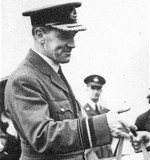
One of the RAF's leading pilots during the Battle of Britain was Adolph "Sailor" Malan DFC. He had been an RAF pilot since 1936 and led No. 74 Squadron during the peak of the battle. Under his leadership, No. 74 became one of the RAF's best units. Malan shot down his first two planes over Dunkirk in May 1940 and claimed five more before the Battle of Britain truly began. Between July 19 and October 22, he shot down six German aircraft. His "Ten Rules for Air Fighting" were printed and put up in pilot rooms across Fighter Command. He was part of a group of about 25 pilots from South Africa who fought in the Battle. Eight or nine of them died during the battle.
Other notable pilots included P/O Albert "Zulu" Lewis, who shot down three German Messerschmitt Bf 109s in one action over France in May. He flew three, four, and five times a day. By September 27, Lewis had 18 victories. He was shot down and badly burned on September 28, missing the rest of the battle. Basil Gerald "Stapme" Stapleton also survived a crash on September 7 while trying to stop bombers from reaching London. Both men later became commanders of RAF squadrons.
The most senior officer of South African origin during the Battle was Air Vice-Marshal Sir Christopher J. Quintin-Brand. He was in charge of No. 10 Group RAF, which covered the South-West of England. He had joined the RFC (Royal Flying Corps) in 1916.
Southern Rhodesia
Southern Rhodesia (now Zimbabwe) was a British self-governing colony in Southern Africa during the Battle of Britain. Three pilots born in Southern Rhodesia took part: Squadron Leader Caesar Hull, Pilot Officer John Chomley, and Flight Lieutenant John Holderness. Hull and Chomley both died. Hull, who was the top RAF pilot in the Norwegian Campaign earlier that year, was killed in a dogfight over south London on September 7, 1940. Chomley went missing over the Channel on August 12, 1940, and was never found.
United States

The RAF recognizes seven aircrew members from the United States who took part in the Battle of Britain. American citizens were not allowed to serve in foreign militaries because of U.S. Neutrality Acts. If an American defied these laws, they risked losing their citizenship and going to prison. It is believed that another four Americans lied about where they were from, claiming to be Canadian or other nationalities.
Billy Fiske was probably the most famous American pilot in the Battle of Britain, even though he pretended to be Canadian at the time. Fiske served with No. 601 Squadron RAF and claimed one kill (though it was not confirmed). He crashed on August 16, 1940, and died the next day.
Other American pilots included:
- Alexander Zatonski, No. 79 Squadron RAF
- Andrew Mamedoff, No. 609 Squadron RAF
- Art Donahue, No. 64 Squadron RAF
- Carl Raymond Davis, No. 601 Squadron RAF
- De Peyster Brown, No. 401 Squadron RCAF
- Eugene Tobin, No. 609 Squadron RAF
- John Kenneth Haviland, No. 152 Squadron RAF
- Phillip Leckrone, No. 616 Squadron RAF
- Vernon Keough, No. 609 Squadron RAF
See also


